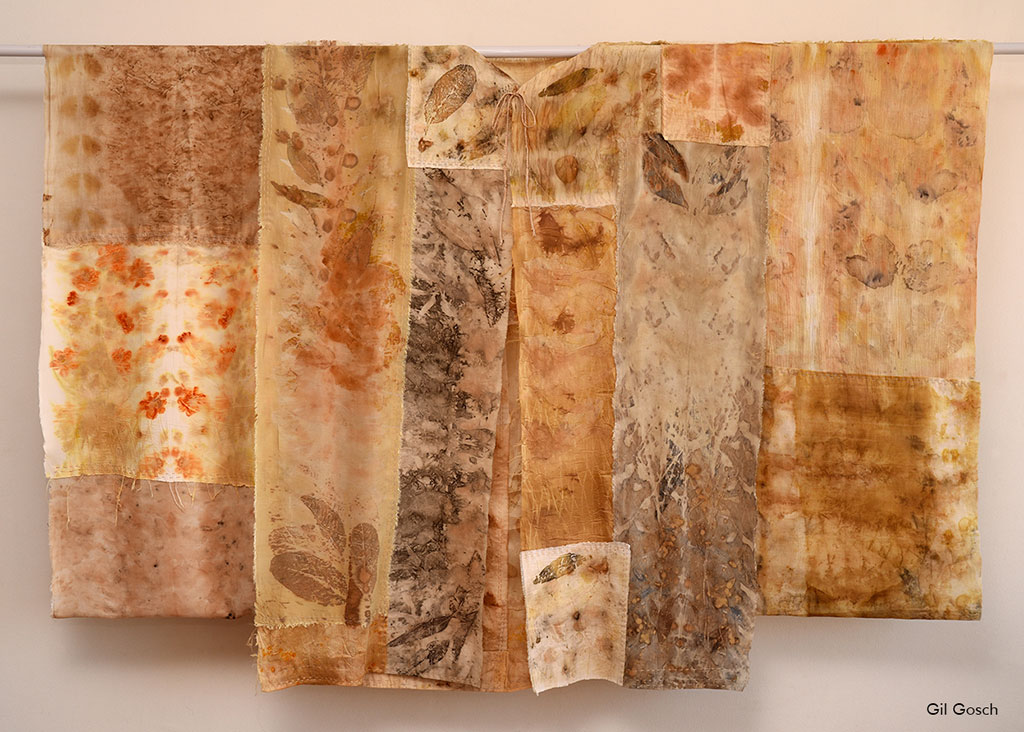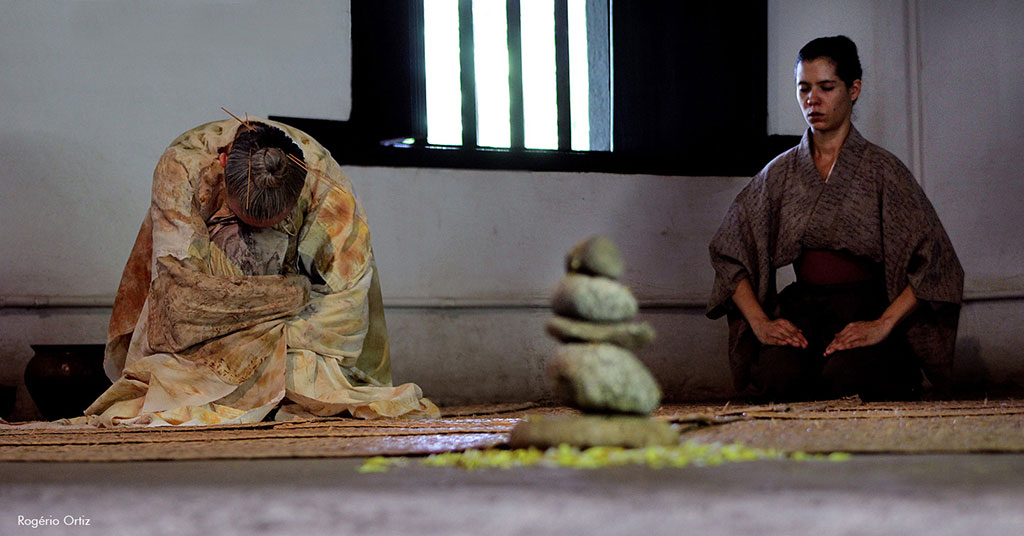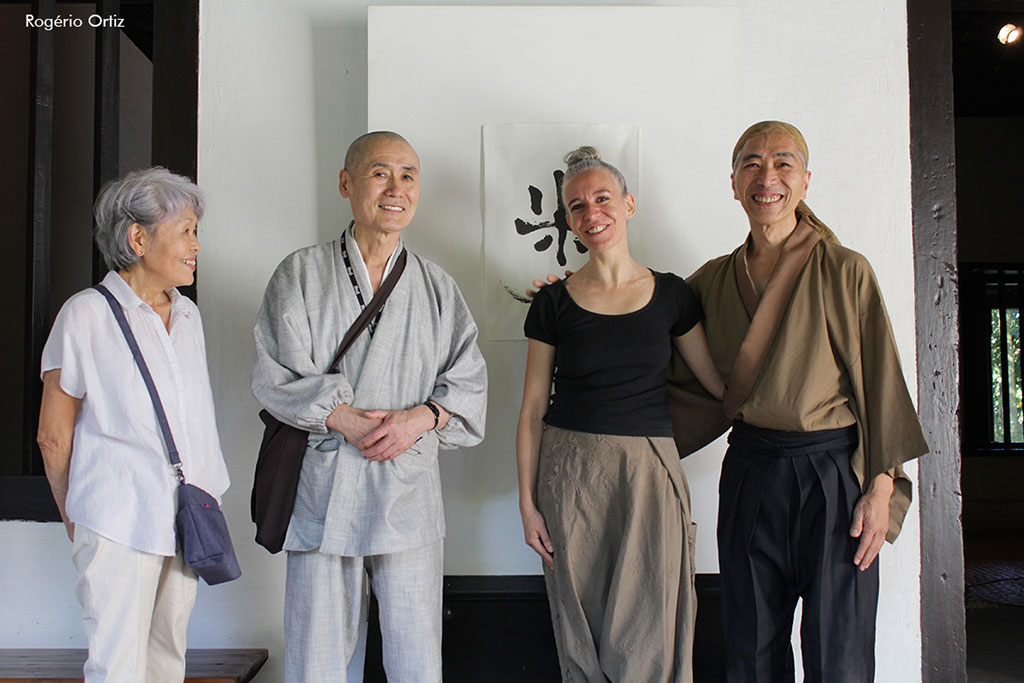
Sometimes the paths are straight and monotonous. But most of the time, they are winding trails, full of ups and downs, and we do not know clearly where we will stop. Here is the delight: we can stop to observe the beauty of the flowers and learn from each person we cross as we walk through them.
My path to natural dyeing began with Each Step, a textile work full of stories which were the result of the same name’s performance. Today it is exhibiting at The Festival of Quilts, a traditional festival in Birmingham, England, which this year, due to the pandemic, was launched in virtual format.
This happy international participation allowed me to reflect on the importance of this first work, made entirely with natural dyeing, in my artistic development. It is also an opportunity to thank the masters and teachers I met along my way and who helped me, and already help, see its beauties.
The Each Step performance

Walk, step by step
breathing the earth under the feet
it is all that exists
here and now
Each Step was born a performance. A dance performance created in 2016 within the Corpo de Vento (Wind’s Body) project contemplated in the 16th Fomento à Dança de São Paulo. It is result of more than 10 years of practicing seitai-ho and participating in artistic research projects and performances of the Fu Bu Myo In Group, directed by Toshi Tanaka.
Seitai-ho is a set of body techniques created by Haruchika Noguchi in early 20th-century Japan that help people return their bodies to the wisdom of nature – what he calls natural order – through vital energy, ki.
The view and teachings of Toshi Tanaka on seitai-ho, guided me in my first dive into Japanese culture. The more I studied katas, as body postures that predisposed me to a natural receptivity to body movement, the more I understood the value of work done with our hands. I realized the importance of traditional and artisanal techniques, which are the base of Japanese culture. From this perception was born the idea of making my costume with handmade natural dyeing techniques.

The Each Step performance is the culmination of my process as a performer. It was created by me, but it would not exist without the direction of Toshi Tanaka, and the exquisite work of Angélica Figuera, Ciça Onho and Toshi Tanaka, who were fundamental stones in the scene.
A new path opens: the botanical colours
Impressão botânica com gerânio, picão-preto, cosmos e folhas de mangueira
Impressão botânica com casca de cebola, hibisco, traporeaba e folha de goiabeira
Impressão botânica com eucalipto, folhas de chapéu-de-sol, goiabeira e flor seca de hibisco
Impressão botânica com folha de goiabeira
The deep dive into Japanese culture, allowed by the creation of the Each Step performance, sprouted the seed of what will be my main activity since then: natural dyeing.
At first, inspired by my fascination with shibori, my research was self-taught – I searched tirelessly for tutorials on the internet and books on the subject. I discovered botanical contact printing, which enchanted me so much. I wrote a text only on this subject in the post Botanical contact printing – A delightful natural dyeing technique. I was never tired of dyeing samples and more samples of fabric scraps, which were hand stitched to shape the Each Step costume. In the photos above, we can see the record of some. Guava leaves, cosmos, hibiscus, onion skin, eucalyptus, geranium, and dandelion are some of the plants I used. I gleaned the plants on the São Paulo streets and in the amazing Casa do Sertanista garden, a venue that served as a stage for the performance.
Casa do Sertanista and it Brazil pine forest: heritage site that was built with rammed earth in the 17th century. Nowadays is a museum.
Each Step costume detail.
The Cada Passo stitching, made by hand, was inspired by the Buddhist monks stitching robes. During the performances, I learned that there is a Japanese embroidery called sashiko. Its stitch runs in a line – exactly what I used to stitch the costume – and it used to join old fabric pieces creating new clothes for poor people in Japan. Definitily, a new and beautiful path opened for me: and how many amazing things to learn!
Dômo arigatô gozaimashita!

This photo had taken on April 17, 2016, after the Each Step show. It is the portrait of my deep gratitude to my master and teachers. On the far left, Hisako Kawakami, my dear sensei of natural dyeing. On my left, Dosho Saikawa Roshi, my lifelong Zen Buddhist master. And on my right, Toshi Tanaka, who has been my seitai-ho teacher for 12 years and director of Each Step. From them, I learned the capital importance of those who walked the paths before us, and our ancestors.
The Esch Step work had and continues to have a very happy trajectory. In the same year of the performance show, it won a gold medal at the 10th Great Bunkyo Art Exhibition at the Brazilian Society of Japanese Culture and Social Assistance in São Paulo – SP. This award earned me a trip to Japan, where I had the great opportunity to get in touch with the traditional Japanese forms of natural dyeing and weaving. I visited the Ars Shimura school of master artisan Fukumi Shimura in Kyoto; the Little Indigo Museum of textile artist Hiroyuki Shindo in Miyama, and the Japanese Botanical Garden of Dyeing Plants in Takasaki.
I already had written a Colors of Japan series, a travel diary retelling my experience visiting these incredible Japanese artists. A way to reciprocate, thank you and share so many beautiful experiences that I learned there. Taking the opportunity to follow the blog, and joining my email list to always stay on top of the latest posts.
See you in the next post!
Dômo arigatô gozaimashita!
To know the pieces handcrafted and dyed with plants e herbs in my online store:

interesting for a very long time